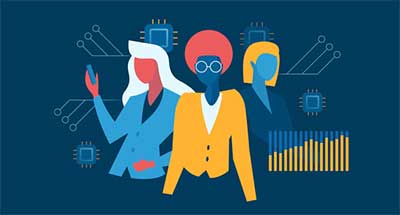Date: 10/03/2023
Relevance: GS-3: Indian Economy and issues relating to planning, mobilization, of resources, growth, development and employment, Inclusive growth and issues arise from it.
Key Phrases: Digital Gender Gap, Poverty, Literacy, Education, UNICEF, Smartphone, Internet, OECD, Pandemic, UNESCO, Digital Sakhis, Demographic Dividend, Digital Transformation.
Context:
- Access to digital technologies is often denied to girls and women due to the patriarchal social order that places them second to men. This reality is confirmed by data on literacy, education, and access to resources.
Digital Disparity:
- According to a UNICEF report digital technology is integral to
90% of jobs worldwide, but these jobs are available only to the digitally
able, and to more men than women.
- In developing countries, women have significantly less access to the internet than men, with only 41% of women having internet access compared to 53% of men.
- Furthermore, women are 20% less likely to own a smartphone and are more likely to borrow phones from male family members.
- The report also highlights that boys are more likely to own mobile phones, including smartphones, than girls.
- The Organisation for Economic Cooperation and Development also
revealed that the gender gap in internet use is widening.
- Additionally, software development continues to be male-dominated, with women comprising only 15% of software designers.
- In India, data shows that only 42% of internet users are female,
compared to 58% male users.
- Moreover, when it comes to first-time internet users, the gender gap is more pronounced, with 57.1% of men having ever used the internet, compared to only 33.3% of women.
- Girls and women are denied access to digital technologies because
they almost always come second in a patriarchal social order.
- The internet is seen as a ‘risk to the traditional social order’ and ‘male gatekeepers’ restrict or control girls’ and women’s access to the internet.
The Post-Pandemic World:
- The COVID-19 pandemic has highlighted the critical importance of digital tools in modern world. As businesses and schools closed, the first jobs to disappear were those requiring physical presence and manual labor.
- Children faced difficulties keeping up with their studies due to
limited access to smartphones and computers.
- UNESCO estimated that approximately 168 million girls across all education levels were impacted.
- Although gender-disaggregated data is scarce, it is possible that some families favored boys with limited digital resources. It would be unwise to assume that a similar situation will not arise again in the future.
- To exclude women from the digital world would be equivalent to depriving them of a fundamental survival skill in today's society
Realizing Potential:
- India has set a target of achieving a $1 trillion digital economy
by 2025, and already, 40% of global digital transactions occur in India.
- In 2022 alone, an astounding 49 billion digital transactions took place in the country. As economies continue to digitize, it is expected that most jobs will require some level of digital technology proficiency.
- Frontline workers are utilizing tablets and smartphones to
complete online forms that feed directly into management information
systems, while public schemes such as the PM Janani Suraksha Yojana
require beneficiaries to provide their bank account details.
- Digital inclusion will be critical for social and financial inclusion.
- There are immense opportunities for girls and women to contribute to and
benefit from India's digital economy.
- With the world's largest young population, nearly half of which are women and girls, access to digital technology can be a game-changer with widespread effects.
- Young women, known as "Digital Sakhis" from Madhya Pradesh, are challenging discriminatory social norms through the use of smartphones, and their efforts give hope that digitally empowered women will lead the transformation in India.
- Leveraging India's demographic dividend will necessitate an equal focus on the country's gender dividend. Educated, economically productive, empowered and socially conscious women and girls are highly valued in any society.
Conclusion:
- A rapid digital transformation is already underway, and bridging the gender gap will require strategic interventions tailored to the needs of girls and women in areas such as health, education, employment, banking, skilling, and transportation.
- In the current landscape, digital literacy for women is a crucial
requirement if India is to achieve its ultimate objective of gender
equality. The Prime Minister has stressed the significance of
'women-led development' as India takes over the G20 presidency.
- Women20, the official engagement platform of the G20 for promoting gender equity, has identified 'bridging the gender digital divide' as one of its five priorities that should be integrated into the G20 agenda this year.
- Creating a supportive policy environment to encourage the digital empowerment of women is a positive move in the right direction.
Source: Live-Mint
Mains Question:
Q. How does digital literacy for women fit into India's goal of achieving gender equality? Discuss (150 words).







